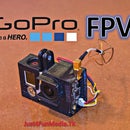Introduction: Compact LED Light Table
I built a compact tracing table (only 2-1/8" thick) to aid in amending plans and sketches. I used RGB LED rope lighting, this allows the tracing table to double as a flood lighting panel and create any one of over a million colours.
This can be used as a:
Video Light
Photography Light
Party Light
Flood Light
Tracing Table
The full build video is embedded below.
For this instructable you will require:
5 meters of 5050 RGB rope lighting (http://www.gearbest.com/led-strips/pp_230511.html)
1 5050 LED controller (http://www.gearbest.com/led-strips/pp_230511.html)
1 Nielsen style picture frame (with glass)
4 Battery Post Bolts (with nuts)
4 Tire Valve Stem Caps (http://www.gearbest.com/car-decorations/pp_1207.html)
Mechanics or Binding Wire
1 12v Power Source or 12v Cable and a Battery pack (http://www.gearbest.com/diy-parts-and-tools/pp_139131.html)
Check Out Our Other Accounts! Like, Subscribe, and Follow to keep up to date with our latest projects. :-)
Step 1: Remove the Glass
Remove the spacers which hold the glass in place using a flat screw driver.
Then unscrew the corners of one side of the picture frame and remove the glass.
Step 2: Layout
Trace out the inside diameter of the picture frame onto a piece of cardboard and determine the best layout for the LED's.
I used a linear propagation and cornered at the edges to avoid soldering.
Step 3: Backing
Cut your backing material down to length and width.
Then mark out the locations for the mechanics wire to secure the rope lighting.
Next, drill out these holes and use a plunge router to router a groove along these holes on the back of the picture frame. This groove will prevent the mechanics wire from snagging.
Step 4: Attach the Frame
Drill four holes in the edge of the backing material for the battery bolts, then secure the picture frame to the backing material.
Step 5: Attach the LED's
Peel the adhesive backing off of the LED's one section at a time. Then secure the ends of the row with mechanics wire, loosely twisting the wire together with your fingers as you go.
Once you have finished the whole board, flip it over and tightly twist the wires together before trimming off any excess and bending them over into the groove.
Step 6: Reassemble
Remove the picture frame from the backing material and reinsert the glass. Attach the control box before reinstalling the picture frame. Place the valve stem caps onto the exposed ends of the bolts to prevent damaging tables the tracing table is place on.
Step 7: Add the Control Box
Drill pilot holes into the back of the tracing table and screw down the control box.
Step 8: Battery Pack
After cutting the end off of an appropriate cable, use a continuity tester to determine which wire is the cold or negative wire (outside casing of plug).
Strip both the wire and battery pack wires before twisting, soldering, and heat shrinking the cable together.
Step 9: Start Tracing
Start tracing.
If you have any questions or suggestions for improvement feel free to comment below or private message me.
Have a great day!

Participated in the
Rainbow Contest 2016

Participated in the
Beyond the Comfort Zone Contest



















